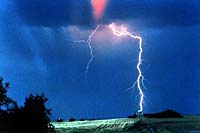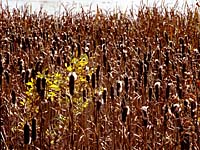
Field and garden fertilizers contain phosphorus and nitrogen, the keys elements required by plants for healthy growth. Other sources of these elements include waste water, domestic sewage and livestock waste. When these substances enter waterways, they boost the growth of algae and other aquatic plants.

The chemical characteristics of phosphorus and nitrogen cause them to find their way to water, even if their source is far removed from the waterbody. Phosphorus sticks to soil particles and nitrogen dissolves in water. Both nutrients can reach lakes and streams in eroded soil and runoff from land. |
Algae, a type of green plant common in all freshwater, undergoes population explosions when fed with nutrients. The algae blooms cover the water's surface with a green carpet that can block out sunlight, limiting photosynthesis underneath. When the algae dies, it settles to the bottom and decays, consuming valuable supplies of oxygen in the water. Some types of algae release substances that are toxic to fish.

The result of the excess growth of algae and other plants can cause fish to suffocate, from lack of oxygen in the water. The algae and plants eventually die, and decomposition of these organisms consumes more oxygen than can be produced by the remaining aquatic plants. In winter, decomposition becomes even more of a problem since ice cover shuts out the air, preventing the water from absorbing more oxygen. Excessive growth of water weeds, like cattails, can hamper fish movement in addition to oxygen 'stealing' during decomposition. |
Domestic sewage and livestock are two more sources of phosphorus and nitrogen. The closeness of disposal systems and feedlots has a direct effect on the amount of these elements entering waterways.